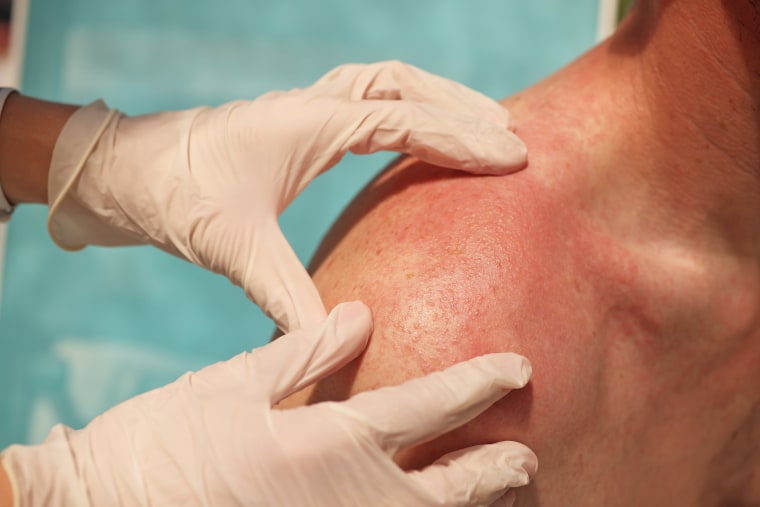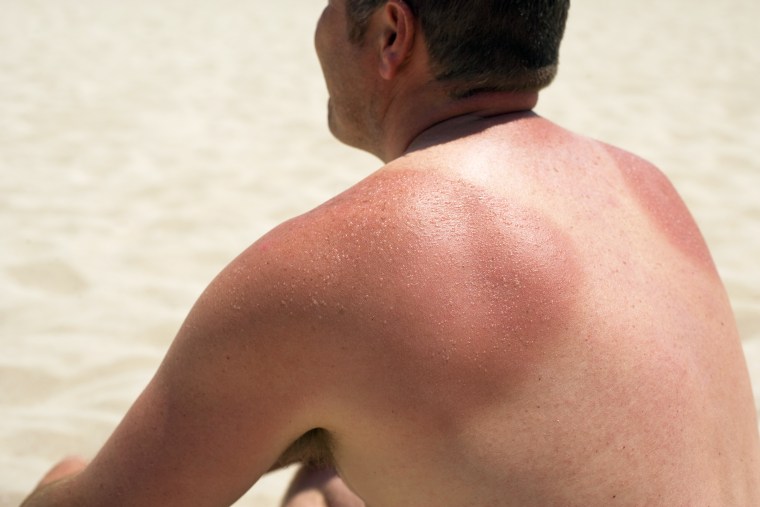With millions of people under heat advisories across the U.S. and as much of the country faces record-breaking temperatures for this time of year, you're probably finding yourself sweating a little more than usual.
And excessive sweating can increase the chances you'll develop heat rash, which, along with body acne and razor burn, can be a pretty common summer skin problem. Heat rash happens when you're sweating so much that the sweat pools underneath your skin. In adults, heat rash is most likely to pop up in areas where your skin is coming in contact with itself, especially the armpits, the groin area and underneath the breasts.
“Sweat is the way the body cools itself, but at the same time, too much sweating or sweat trapped below the skin can be irritating,” Dr. Anne Chapas, member of the American Academy of Dermatology and a board-certified dermatologist based in New York City, tells TODAY.com.
What is heat rash?
You may've heard heat rash referred to as "prickly heat" or "miliaria." These are all the same condition, where the skin becomes irritated because sweat gets trapped underneath it. The rash itself may actually appear more similar to blisters or bumps. And you may find yourself tempted to scratch because it's itchy, but don't, as scratching can increase the risk of the rash getting infected.
“When there’s too much heat and humidity, the sweat glands can clog up,” Dr. Danny Del Campo, member of the American Academy of Dermatology and board-certified dermatologist based in Chicago, tells TODAY.com. “You’re sweating so much, and your skin can’t breathe.” Your body tries to pump out more sweat, but it can’t, so you develop an inflammatory state with redness and sometimes bumps and blisters.
“We’re all sweating, especially if we’re working out. It’s easy to get heat rash in places where skin touches other skin,” Dr. Anthony Rossi, member of the American Academy of Dermatology and board-certified dermatologist based in New York City, tells TODAY.com.
"It's a very, very normal thing that can happen," NBC News medical contributor Dr. Natalie Azar said in a TODAY segment on May 31.
Infants have an increased likelihood of developing heat rash due to a few different factors, such as swaddling, immature sweat glands and being less able to regulate body temperature, and having more skin folds. In babies, heat rash is common on the underarms, neck, groin and inner thighs, and buttocks.
Heat rash on adults is most likely to pop up in skin folds and parts of the body covered by clothing because this can prevent the sweat from evaporating properly, according to Mayo Clinic.
In addition to increasing your risk of heat-related illness, exercising when it's hot out can lead to heat rash, especially if your workout clothes are tight-fighting and not made from breathable fabrics.
What does heat rash look like?

Heat rash usually looks like small red bumps and blotches, which are often itchy. Bumps on the skin filled with fluid may also develop as part of a heat rash. These bumps and spots will normally develop suddenly, no more than a few hours after the sweating episode that caused it. According to Mayo Clinic, heat rashes can look like:
- A group of small bumps that can look like pimples or blisters and are fluid-filled and may break open
- Deeper bumps in the skin that itch or prickle
- Pus-filled bumps
- Bumps similar to goosebumps that may break open
Even if your rash gets itchy, remember not to scratch it. Scratching can cause an infection by opening up the skin and potentially letting in bacteria.

How to get rid of heat rash quickly
The best ways to get rid of heat rash fast involve keeping your skin cool and avoiding additional sweat.
- Get out of the heat. Azar recommended getting to an air-conditioned, cool environment to cool your body down.
- Take a cool shower, pat your skin dry with a towel or let your body air dry. You can also try cool compresses.
- Avoid excess sweating. For example, don't exercise and try to avoid being outside if it's hot and humid.
- Change into loose, breathable clothing. Wearing loose clothing and not too much clothing can help your body cool down and dry off, Azar said. Avoid clothing in synthetic materials. For babies suffering from heat rash around the groin or buttocks, consider removing their diaper.
- Use antihistamines. This is especially helpful if your rash is itchy, Azar said. You can use a cream or take them by mouth.
- Use a moisturizer, anti-inflammatory lotion like calamine lotion, or over-the-counter steroid creams. Keep your moisturizers in the fridge for a maximum cooling effect, Del Campo suggests.
- Try oatmeal. Azar said that you can make an oatmeal paste at home or put it in the bath and soak.
How to prevent heat rash
You’re less likely to develop a heat rash if you stay cool and dry, so many of the tips to treat heat rash quickly are similar to those to prevent it altogether.
- Choose your exercise clothes wisely. Wear clothing that wicks away sweat so you’re not trapping sweat against your skin. Cotton doesn’t irritate your skin, but it doesn’t wick away moisture either. “Newer sports fabrics do a good job of wicking moisture away, but they are very compressing against skin. If you leave them on too long you can break out in a heat rash,” Rossi says.
- Keeping your skin cool and dry. “The most important thing is to change out of those sweaty clothes quickly,” Chapas says. “Take a cool shower to cool down your body and change into a clean shirt.”
- Wear lightweight clothing, especially clothes that don't rub against your skin.
- Try to stay in cool environments when it's hot out. Avoid exercising when it's super hot.
- Stay hydrated.
- Use antifungal powders, especially in your groin folds and armpits, to help absorb moisture.
How long does heat rash last?
Once your body cools down, your heat rash will go away within one to three days, according to the Cleveland Clinic. Heat rashes that turn into pimples can take longer. If your rash isn’t getting better in a few days after using at-home treatments, see a doctor.
If your heat rash seems to be getting worse after at-home treatments or is showing signs of infection — such as draining, redness, fever, nausea or increased pain, especially in children, who may be more prone to scratching the rash — see a health care provider.
A rash that’s not clearing up could be another type of rash, bug bites or a viral infection. “If your rash isn’t associated with sweating or is spreading to other parts of your body like your chest, back or legs, it could be something else,” Chapas says.
Heat rash can also be a warning sign that you’re overdoing it in the warm weather. Don’t ignore it — overheating can also lead to heat stroke and heat exhaustion. And too much time in the sun can cause sunburn and sun poisoning.